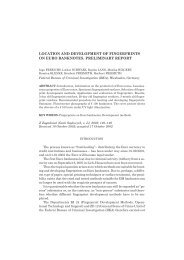Pobierz PDF - PROBLEMS OF FORENSIC SCIENCES
Pobierz PDF - PROBLEMS OF FORENSIC SCIENCES
Pobierz PDF - PROBLEMS OF FORENSIC SCIENCES
Create successful ePaper yourself
Turn your PDF publications into a flip-book with our unique Google optimized e-Paper software.
426<br />
rate conclusions. unfortunately, though, research has<br />
shown [18] that this increases accuracy only slightly<br />
and that including data from these techniques reduces<br />
the accuracy of decisions taken based on the totality<br />
of diagnostic material. though miller and Nickerson’s<br />
review of the research [38] found projective<br />
techniques potentially useful for generating diagnostic<br />
hypotheses, it did not find them very effective in increasing<br />
the accuracy of conclusions or decisions.<br />
this leads us to an important conclusion: the projective<br />
method offers neither an easy insight into personality<br />
nor produces results that are “better” than the<br />
so-called objective methods. what is more, when used<br />
in a non-standard way and without the required degree<br />
of thoroughness they lead to false diagnoses. Despite<br />
prevailing opinion, the use of these methods requires<br />
greater competence and more discipline than do, for<br />
example, assessments made with the questionnaire<br />
method.<br />
4. projective techniques and those mistakenly<br />
described as projective<br />
let us return to the central issue of whether all of<br />
the techniques bearing that name truly are projective.<br />
Do they all seek to understand the private world of<br />
meaning of those being examined? Do they all attempt<br />
to comprehend the way those examined organise<br />
their experiences? Surely not: some of the techniques<br />
known as projective are not even oriented at the level<br />
of their assumptions to recognising the subjective and<br />
individual meanings that are specific to people’s individuality.<br />
instead they focus to a greater degree on<br />
assigning characteristics according to a dictionary of<br />
signs developed a priori, or on shunting people into<br />
an a priori defined category, not to say pigeonhole.<br />
let us now examine so-called colour diagnostics from<br />
the same point of view. the lüscher colour test [34]<br />
attempts to define a person’s character based on colour<br />
preferences. the flaw here, though, is that there is no<br />
room for projection either in the sense of a process of<br />
perception or in the sense of a defence mechanism.<br />
the lüscher colour test involves a curious process<br />
of categorising people into groups that like this or that<br />
colour. the colours yellow and red, for example, are<br />
supposed to select extroverts, while a preference for<br />
green and blue selects introverts [46]. Violet, on the<br />
other hand is supposed to be the colour preferred by<br />
those who are unsure of their sexual identification, homosexuals,<br />
pre-pubescent children and women – especially<br />
pregnant ones [23]. the same applies to the<br />
“meaning” of colours in projective drawings – espe-<br />
Problems of Forensic Sciences 2013, vol. 93, 421–437<br />
K. Stemplewska-Żakowicz, W. J. Paluchowski<br />
cially those done by children. it is not rare for clinicians<br />
and pedagogues to draw conclusions about the<br />
emotional state and affective aspects of a child’s personality<br />
based on the colour of a crayon. when doing<br />
so, moreover, they use the popular symbolism of colours<br />
in the majority of cases, which translates red as<br />
aggression and black as depression [8].<br />
No matter what meanings those examined attach<br />
to the chosen colours the diagnostician “knows better”<br />
what they symbolise, “knows” their universal<br />
meaning and uses this “knowledge” to formulate an<br />
“individual” diagnosis. this approach has nothing to<br />
do with projective diagnosis. what is more, none of<br />
the “meanings” of colours set out above accurately<br />
describe the personality of those who select them. as<br />
the authors of these tests have not themselves provided<br />
sufficient evidence of their accuracy, other scholars<br />
have conducted studies testing the statements made<br />
on the relationship between colour preferences and<br />
personality. this research has invariably found that<br />
there is no reason to think that someone who selects<br />
a different colour from someone else is also different<br />
with regard to a particular psychological characteristic.<br />
in a study devoted to the “psychology of the<br />
colour violet” [23], for example, an enormous sample<br />
of approximately 1200 psychiatric patients aged between<br />
7 and 93 was examined with the lüscher test.<br />
No relationship was found between the preference for<br />
violet and age or sexual identification. Furthermore,<br />
those who preferred red and yellow were no different<br />
on extroversion and introversion from those who preferred<br />
green and blue [46]. where the colours selected<br />
by children in their drawings are concerned, studies<br />
[8] have found them to have no universal, extra-individual<br />
meaning. in general, children use colours they<br />
like – especially when drawing “kind” figures. when<br />
drawing “unkind” figures, though, they use a mixture<br />
of colours they like and colours they dislike. that is all<br />
that can be stated in general terms, as each child prefers<br />
one set of colours over another and it is in relation<br />
to this that meaning is to be sought in the drawings.<br />
this research illustrates the principle that it is worth<br />
discussing the selection of colours during the interview,<br />
but it is not worth drawing conclusions based on<br />
the selection itself. there have been other investigations<br />
of colour preference (mostly of the lüscher test)<br />
as a base for diagnosis. all have reached negative conclusions,<br />
while some have gone so far as to warn clinicians<br />
against using the lüscher test as a diagnostic<br />
tool [11; see 22]. convincing experiments have been<br />
performed proving that the accuracy of the lüscher<br />
test as perceived from a phenomenological perspec-
















